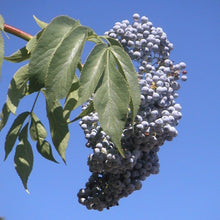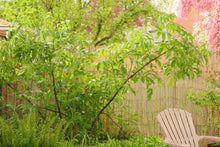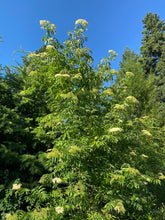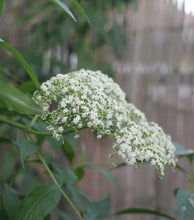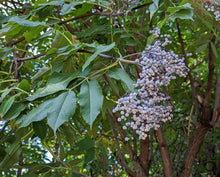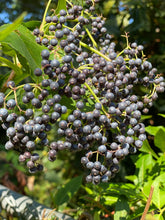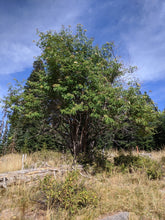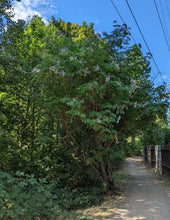
Sambucus caerulea (syn S. nigra ssp. caerulea, S. mexicana, S. mexicana ssp caerulea)
Blue elderberry is a very large, deciduous shrub with countless ecological and wildlife benefits and a rich ethnobotanical legacy. It is extraordinarily fast growing and hardy in the right conditions, quickly establishing many small trunks that create a fountain shape that becomes covered with dense flat-tops clusters (aka umbels) of creamy white flowers in late spring and early summer. The pollinated flowers become powdery blue berries that usually ripen in September and are edible to humans and adored by 30+ species of bird that feast on them as a critical food source during their fall migration.
- Plant type/canopy layer: deciduous, perennial, large shrub
- Size at maturity: 10'-30' tall, equally as wide (lower branches can easily be pruned up so it occupies less space down low)
- Light requirements: full sun, part sun/part shade
- Moisture requirements: moist to dry soil
- Bloom time: May - Aug (May - June in the Portland Metro area)
- Growth rate/ease: fast growing, easy to grow in the right conditions
- Wildlife support: young shoots and leaves are food for deer and elk; pithy stems are excellent habitat for mason bees; flowers attract and provide nectar to hummingbirds, adult butterflies, bees and other insect pollinators, as well as beneficial, pest-eating insects; berries attract and are an important food source for squirrels, chipmunks, and over 30 species of local birds including jays, woodpeckers, pigeons, grosbeaks, robins, thrushes, bluebirds, towhees, and tanagers; overall plant is a caterpillar host and larval food source for over a dozen of species of native butterflies and moths such as the White-lined Sphinx moth and Virginian Tiger Moth aka Yellow Wooly Bear moth and provides cover and nesting sites for birds; dead elder wood is the preferred habitat of the mushroom Auricularia auricula-judae, also known as Judas’ ear fungus or wood ear fungus
- Native habitat/range: common in open areas of mixed conifer forests and forest-steppe transitions, in chaparral, sage scrub, grassland, and wetland-riparian habitats, from sea level to 3000m, southern British Columbia to California and western Montana through west Texas. Portland Plant List - yes.
- Special features & uses: wildlife favorite; relatively deer resistant once established (young shoots may need protection in rural landscapes); landscape uses include butterfly and pollinator gardens, erosion control, slope stabilization, and hedgerows. Elderflowers can be used in syrups, cordials and liqueurs. The fully-ripe fruit is edible, highly nutritious and is traditionally eaten fresh, dried, steamed or boiled and used in wine, jellies, candy, pies and sauces. Please take note that unripe fruit can cause an upset stomach and all green parts of the plant are poisonous and create cyanide-producing glycosides. Many people choose to cook and strain the berries before consumption. Always verify recipes from multiple sources when preparing wild foods. Most plant parts are considered highly medicinal; bark and leaves can be to induce vomiting and as a laxative and applied externally for pain, bruises, swelling, and as an antiseptic; flowers and berries can be made into a tea or syrup to treat cold and flu symptoms. This species has many other ethnobotanical values as well; the berries can be used to make black or purple dye, the stems make an orange or yellow dye and are excellent as twisting sticks to start a fire and as a bellow to blow air into it; hollow stems have been used in instruments for thousands of years and can also be made into pipes, blowguns, squirt guns and whistles, which indigenous people use to call elk; the pith was traditionally used by watchmakers for intricately cleaning tools. Lastly, elder trees are also considered sacred in Celtic folklore and mythology and used in making wands.
Gardening with Blue Elderberry: This miracle sprout can grow from a one gallon pot into a 15’ plant in just a couple years, making it an ideal choice for new gardens and/or places where you want a hedge or barrier established quickly. It also provides a lovely mid-layer between taller trees and low perennials, that is highly attractive to the human eye, as well as wildlife. Planting several will encourage more flowers and fruit. Be sure to plant it in most-to-full sun locations, where it has plenty of space to grow huge. It tolerates a variety of soils, but will be happiest with medium to fast drainage. Once established, it is highly drought tolerant and only needs to be deeply watered once per month, if at all. It also readily accepts pruning, which some gardeners appreciate because its form can get a little bonkers. But most habitat gardeners quickly learn that most birds seem to prefer the wild form. Plus, superstition declares that one must apologize three times to an elder when pruning or cutting it down, lest you be struck by bad luck!
Elderberry can be difficult for us to source in the quantities we need because it is a difficult species for growers to hold in the pot over the winter without rotting. Therefore, they usually just pot up a small crop in late winter that will sell-out by fall, so they don't have to risk holding it over. These plants that are potted in late winter usually will not be well-rooted until May. If you pick-up this plant at a spring event, it needs to be planted with care or held in the pot until fall.
Companion Plants: Try it in open areas with other shrubs such as serviceberry (Amelanchier alnifolia), baldhip rose (Rosa gymnocarpa), and red flowering currant (Ribes sanguineum); larger herbaceous plants such as lady fern (Athyrium filix–femina) and goatsbeard (Aruncus dioicus var. acuminatus); with sweet groundcovers such as candyflower (Claytonia sibirica), Western buttercup (Ranunculus occidentalis), fringecup (Tellima grandiflora) and dagger-leaf rush (Juncus ensifolius).
Photo Credit 1 (berries): River Wild Photography: Facebook, Instagram
Photo Credits 2, 3, 6 (young shrub in habitat garden, flowers, berries): Karli Del Biondo, Beetles and Bees
Photo Credit 4 (suburban): © Mason Heberling, some rights reserved (CC-BY)
Photo Credit 5 & 8 (leaves/berries, along alley): © Dominic Gentilcore, some rights reserved (CC-BY)
Photo Credit 7 (in the wild): © David Anderson, some rights reserved (CC-BY)








